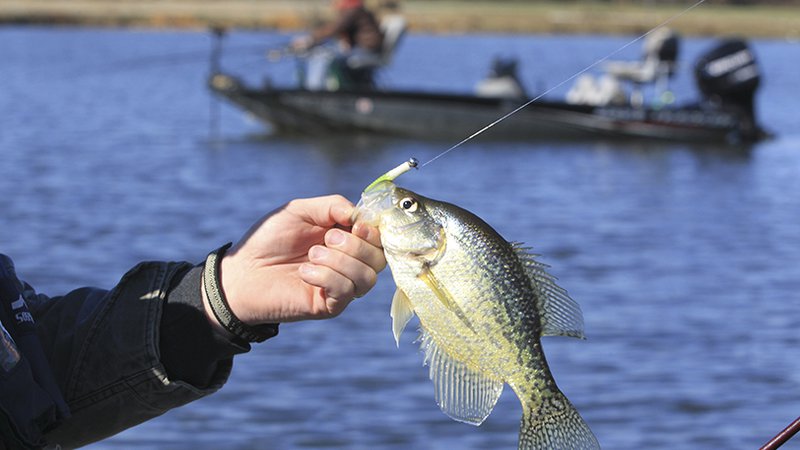Plastic’s fantastic for the crappie spawn
ON 04-18-2018

April 18, 2018
Randy Zellers
Assistant Chief of Communications
CAMDEN – As crappie across the state are hitting their stride, many anglers are relying on the old faithful offering of a fathead minnow or “shiner” dangling from a size 2 Aberdeen hook. There’s no doubt that there’s nothing like the allure of a real meal to fish, but many anglers do just as well using soft-plastic imitations.
South Arkansas crappie addict Andy Yung often forgoes the minnow in favor of a jig tipped with a plastic, although he’ll be the first to tell you live bait always has a place.
“If you can’t get bit on live bait, you usually can’t get bit,” Yung said. “But there are times when plastic baits are just as effective.”
Yung, who happens to also be the fisheries supervisor for the Arkansas Game and Fish Commission at the Camden Regional Office, says his switch to soft-plastics was more a matter of convenience.
“I really just wanted to skip the extra trip to the bait shop before fishing or dealing with minnows overnight and between trips,” Yung said. “I can keep some jigs, curly tails, tubes and shad bodies stashed just about anywhere and be ready to fish as soon as I get the urge. You can even keep a pack of your go-to baits for crappie in the glove box or console of the truck and have a rod in the back in case of a last-minute need to escape during the spawn.”
Yung says there are even times that an angler using artificial lures will out-produce live bait because they are more efficient. When fish are biting, baiting up with a fresh minnow can take much longer than simply dropping your jig back to the sweet spot of a brush pile or stump line. It’s also one more distraction that can cause you to drift right into the fish, spooking them.
Another benefit over live bait is preventing waste at the end of the day. Many anglers think they’re not doing any harm to a lake by dumping their bucket of minnows into its waters at the end of the day, but the best practice to dispose of live bait is to drain the water and empty the minnows on land.
“It really seems cruel to just dump the minnows like that, but it’s what’s best for the lake,” Yung said. “Diseases like Largemouth Bass Virus and invasive species like silver carp and white perch (an invasive that has done damage to some Midwest fish populations) can be spread by such bait bucket stockings. Round gobies in the Great Lakes are other non-native bait bucket transplants that have really altered the lakes they’ve been introduced to.”
Yung says he actually didn’t get to do much spring fishing when he was growing up, because he lived on a farm in northern Illinois. Spring and fall were extremely busy, so his fishing often had to take a backseat until the dog days of summer.
“I learned to fish for crappie at one of the worst times to fish for them, but I think it made me better at figuring them out,” Yung said. “Crappie fishing is probably my favorite thing to do, so when I joined (the AGFC) I jumped on the crappie management team as fast as I could.”
So what is the one soft-plastic bait Yung will never be caught without?
“Different lakes and water clarities may call for different colors and lure styles, but I’ve always got the most confidence in black and chartreuse and in shad-style bodies like Panfish Assassins and Bobby Garland Baby Shads,” Yung says. “It’s like the black-and-blue bass jig for bass anglers, and it’s likely going to catch a random redear sunfish or bluegill to throw in the fish basket, too.”
If Yung doesn’t see success with the black/chartreuse shad body, he’s also apt to try a Crappie Slider, especially if the water is clear and he’s casting to spots instead of dropping straight down on the fish.
“Lakes like Columbia near Magnolia can get super clear; I’ve seen fish spawning 8 to 10 feet deep there,” Yung said. “If it’s like that, I want to cast that Slider and retrieve it back slowly. But lakes like (Mike Knoedl) Tri-County Lake near Fordyce have enough stain to get closer. I’ve caught crappie dropping straight down on them over fish attractors in 10 to 12 feet of water.”
Above all, Yung says the key to crappie is to keep at it. You may slay the fish one day, only to have them develop lockjaw the next, or even shut down midway through your day. To you, nothing may have changed, but something changed to them to shift their attitude.
“Change up colors and keep plugging until you find out what they want for that day,” Yung said. “It can be frustrating even to veteran anglers, but figuring out the pattern they want is one of the best feelings in fishing.”
Recent News
Subscribe to Our Weekly Newsletter E-mails
Don’t miss another issue. Sign up now to receive the AGFC Wildlife Weekly Newsletter in your mailbox every Wednesday afternoon (Waterfowl Reports are published weekly during waterfowl season and periodically outside the season). Fishing Reports arrive on Thursdays. Fill in the following fields and hit submit. Thanks, and welcome!


